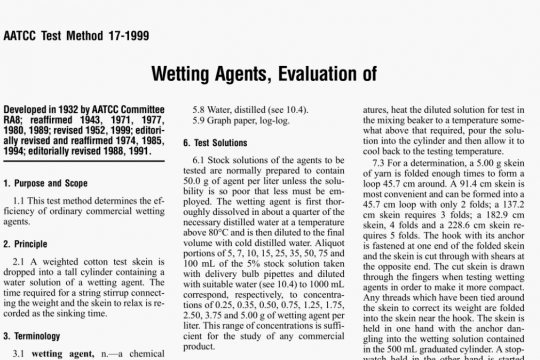AATCC 133 pdf free download
AATCC 133 pdf free download.Colorfastness to Heat: Hot Pressing.
1. Purpose and Scope
I . I This test method is intended for determining the resistance of the color of textiles of all kinds and in all forms to color change, and color transfer when subjected to hot pressing. Tests are given for hot pressing when the fabric is dry, damp and wet. The textile end usc usually determines which tests should be made.
2. Principle
2.1 Diy Pressing. The dry specimen is pressed with a heating device of a specified temperature, time and weight.
2.2 [)amp Pressing. The dry specimen is covered with a wet, undyed cotton cloth and pressed with a heating device of a specified temperature, time and weight.
2.3 Wet Pressing. The wet specimen is covered with a wet, undyed cotton cloth and pressed with a heating device of specified temperature and weight.
3. Terminology
3.1 colorfastness, n.—the resistance of a material to change in any of its color characteristics, to transfer of its colorant(s) to adjacent materials or both, as a result of the exposure of the material to any environment that might be encountered during the processing, testing. storage or use of the material.
3.2 hot pressing, n.—aprocess for smoothing and possibly shaping textile products by applying mechanical pressure with heat, either dry or in the presence of moisture.
4. Safety Precautions
NOTE: These safety precautions are for information purposes only. The precautions are ancillary to the testing procedures and are not intended to he all inclusive. It is the user’s responsibility to use safe and proper techniques in handling materials in this test method. Manufacturers MUST be consulted tlw specific details such as material safety data sheets and other manufacturer’s recommendations. All OSHA standards and rules must also be consulted and followed.
4.1 Good laboratory practices should be followed. Wear safety glasses in all laboratory areas.
5. Apparatus and Materials
5.1 Heating device, providing even heat transfer to the specimen from the top by close contact at a controlled temperature (see 7.1, 12.1, 12.2 and 12.5) and giving a pressure on the specimen of 40 10 g/cm (see 12.4).
5.2 A smooth heat resistant sheet (see
12.3 and 12.9).
5.3 Wool flannel of approximately 260 gIm2 (see 12.4). Two layers of this material are used to make a pad of approximately 3 mm thickness. Similar, smooth wool fabrics or felt to give a pad about 3 mm thick could be used.
5.4 An undyed, bleached and not mercerized cotton cloth, with a smooth surface lOO-130g/m.
5.5 Gray Scale for Color Change (see
12.8).
5.6 Gray Scale for Staining (see 12.8).
5.7 AATCC Chromatic Transference Scale (see 12.8).
6. Test Specimen
6.1 If the textile to be tested is fabric, a piece 12 x 4 cm is required.
6.2 If the textile to be tested is yam or thread, knit it into a fabric and use a piece 13 x 4 cm or wind it around a piece of thin inert material 12 x 4 cm to obtain the area of the textile for test.
7.3 The bottom plate of the heating device is covered with the heat resistant sheeting (see 5.2, 12.3) wool flannel (see 5.3. 12.3) and dry. undyed cotton cloth (see 5.4, 12.3 and 12.4).
7.4 Dry Pressing. Place dry specimen on top of the cotton cloth covering the wool flannel pad (see 7.3, 12.3). Lower top plate of heating device and leave specimen for 15 s at the specified pressing temperature.
7.5 Damp Pressing. Place dry specimen on top of the cotton cloth covering the wool flannel padding (see 7.3, 12.3). Soak a piece of undyed cotton cloth 12 x 4 cm in distilled water, and squeeze or extract it to contain its own weight of water. Place the wet cloth on top of the dry specimen. Lower the top plate of the heating device and leave specimen for 15 s at the specified pressing temperature.AATCC 133 pdf download.




